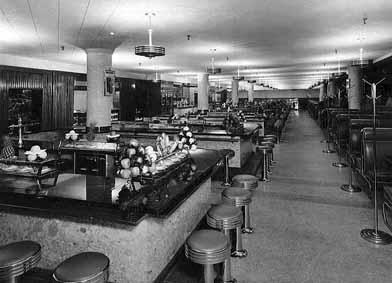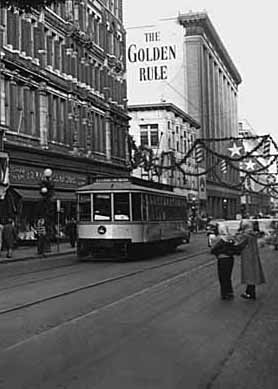Difference between revisions of "The Golden Rule/Emporium Department Stores"
m (Protected "The Golden Rule/Emporium Department Stores" [edit=sysop:move=sysop]) |
|
(No difference)
| |
Latest revision as of 11:26, 1 May 2010
At opposing corners on the north side of Robert Street and Seventh Street, St. Paul, MN
(Emporium: 1920-1967[closed]-Present) (Golden Rule: 1914-1980[moved/closed]-Present)
| Department stores are likely the longest-lasting queer sites in Twin Cities history. For most of the twentieth century, the impressive palaces of consumerism were places to see and be seen. Those appearing to be part of a upwardly-mobile class could (and still do) cruise for hours on the various floors under the guise of shopping for clothing and furniture.(1)
|
The Emporium's basement Tea Room in 1937. "Tea Room" became synonymous with cruisy toilets by 1970, when Laud Humphrey wrote a shocking expose on the clandestine activity. |
| The Golden Rule on Christmas Day in 1949. |
The Golden Rule was built six years before the Emporium, in 1914.(3) Located at the intersection of Seventh and Robert Streets, the two department stores competed for business at the busiest intersection of trolley lines in St. Paul. At the time, the stores sold everything from dresses to televisions to Christmas hams. The stores suffered with the development of suburban shopping centers and the downfall of the trolley system, and both stores closed in the late seventies.(4)
|
(1) Humphreys, Laud. Tearoom Trade: Impersonal Sex in Public Places. New York: Rutgers, 1970. Page 157.
(2) Brown, Ricardo J. The Evening Crowd at Kirmser's: A Gay Life in the 1940s. Minneapolis: University of Minnesota Press, 2001. Pages 8, 116-119.
(3) http://www.placeography.org/index.php/Golden_Rule_Building,_85_7th_Place_East,_Saint_Paul,_Minnesota
(4) http://www.emporis.com/application/?nav=building&lng=3&id=317580
Part of Minneapolis/St. Paul, MN: 100 Queer Places in Minnesota History, (1860-1969), (1969-2010)

